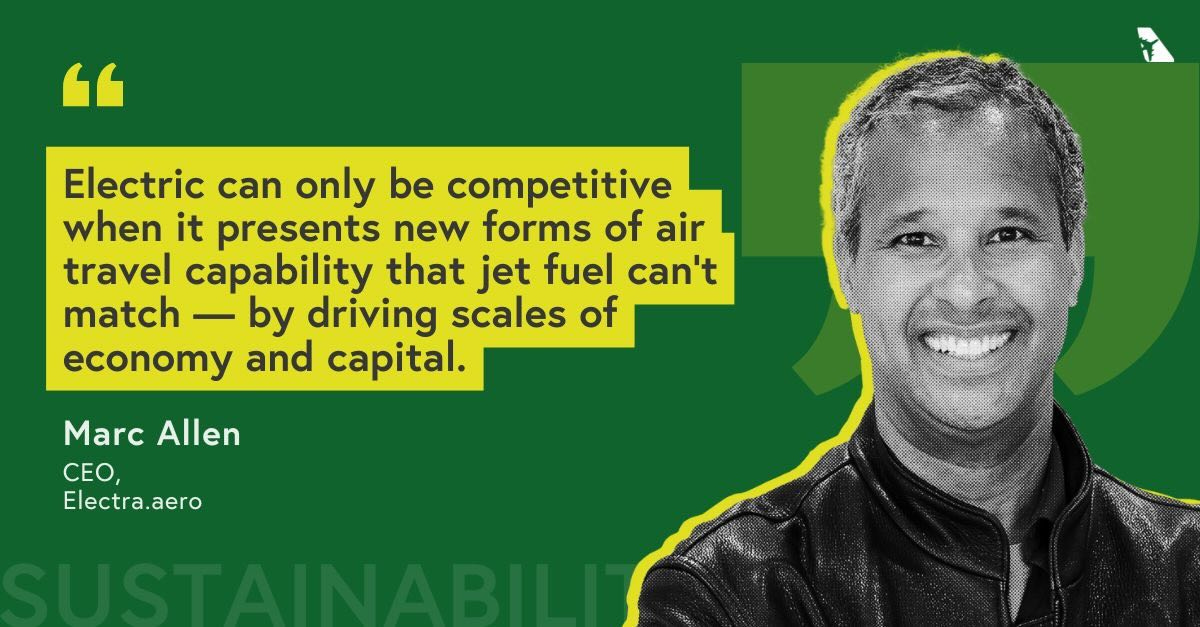In this episode of our ‘Sustainability in the Air’ podcast, Marc Allen, CEO of Electra, speaks with SimpliFlying’s CEO Shashank Nigam about how the hybrid-electric aircraft company is using its patented blown-lift technology to make regional air travel more accessible.
Electra’s groundbreaking EL9 Ultra Short hybrid-electric aircraft has secured over 2,200 pre-orders from over 60 operators globally. The 9-passenger piloted aircraft can take off and land in as short as 150 feet, and operates with lower emissions and noise than conventional planes. Valued at nearly $13 billion, Electra’s order pipeline is one of the largest in the Advanced Air Mobility (AAM) industry.
Electra is one of the visionary companies featured in our new book Sustainability in the Air: Volume Two. You can learn more about the book and order a copy here.
Here are the key highlights of the conversation:
How electric aviation can become competitive (7:22)
Why Electra chose Part 23 over powered lift regulations (9:23)
Blown-lift technology: Creating virtual wing structure (11:24)
The four-pillar value proposition: access, noise, cost, emissions (18:26)
Military applications: From cargo missions to mobile power generation (22:13)
Strategic partnerships with Safran, Honeywell, and Lockheed Martin (24:51)
Sustainability vision: Making the whole system sustainable (26:44)
Scaling blown lift to 100-200 passenger aircraft (31:24)
Rapid Fire! (33:49)
Keep reading for a detailed overview of the episode.
Why Electra’s blown-lift technology matters
Electric aviation faces a fundamental challenge: compared to jet fuel, batteries store far less energy per unit of weight, limiting the range and payload of electric aircraft. As Allen notes, jet fuel is “40 to 50 times as energy efficient on a weight-adjusted basis”, giving jet fuel a significant advantage over batteries.
In light of this reality, Allen argues that electric aviation should not aim to replicate the missions already well-served by jet engines. Instead, it must focus on enabling entirely new capabilities, applications where electric propulsion can deliver value that traditional systems cannot.
Electra’s approach is based on an aerodynamic principle known as blown-lift technology. By placing eight electric propellers along the wing and directing airflow over the wing and flaps, the aircraft generates significantly more lift than conventional designs.
Allen explains that conventional airplanes typically achieve lift coefficients of around 2 to 3. This coefficient is a measure of how efficiently the wing generates lift relative to its size and speed. Electra’s two-seat prototype, the EL2, was originally designed to reach a lift coefficient of 9. In actual flight demonstrations, however, it has achieved lift coefficients closer to 13. Electra’s EL9 aircraft has also been modelled to achieve similar performance levels.
This enables fixed-wing aircraft to take off and land like a helicopter, while preserving the cost-efficiency and safety of traditional airplanes. “It’s so counterintuitive,” Allen says, “because for over 100 years, we’ve seen fixed-wing aircraft operate in a predictable way.”
4 takeaways from the conversation
1. Creating a comprehensive value proposition beyond emissions
Electra has built its business model around four interconnected value propositions that address diverse customer needs and sustainability goals. These include: access, noise, cost and emissions. This approach has helped Electra attract a wide and varied customer base.
Commercial operators, for instance, are drawn to the aircraft’s ability to operate from noise-sensitive airports that are increasingly at risk of closure. “We have a lot of commercial customers in the United States dealing with airports being shut down due to noise restrictions,” Allen notes.
In Europe, operators are especially focused on emissions, as carbon-heavy operations face growing regulatory and tax pressures, shares Allen.
For helicopter operators, cost is a major driver. Electra’s EL9 offers the same mission capability, with greater speed and range, at roughly 70% lower cost compared to conventional helicopters, he adds.
Defence customers, meanwhile, are drawn to the aircraft’s tactical flexibility and onboard power generation. As Allen puts it, the aircraft “becomes a generator” upon landing, capable of providing a steady 600 kilowatts of power with bursts up to one megawatt, an asset in remote or forward operating environments.
This comprehensive value creation strategy reflects Allen’s belief that sustainable aviation must deliver economic value alongside environmental benefits. “We’re not building a company for the winds of fashion. We’re building a company to create value. That value will create sustainable air travel for communities everywhere.”
2. Achieving certification advantages through conventional design
One of Electra’s key competitive advantages lies in its certification strategy. While many advanced air mobility companies are dependent on entirely new certification frameworks, Electra has deliberately positioned itself within existing aviation regulations.
“We are fundamentally different from every other advanced air mobility effort,” Allen explains. “They rely on a completely new set of regulations: powered-lift certification standards. We don’t. We’re certifying as a Part 23 aircraft.”
This regulatory alignment stems directly from Electra’s design philosophy. The aircraft features fixed wings and fixed propellers, avoiding complex mechanisms like tilt rotors or rotating wings.
By adhering to a conventional configuration, Electra benefits from well-established certification pathways. The aircraft’s turbo generator, a central component of its hybrid-electric propulsion system, resembles an auxiliary power unit (APU) used on large commercial aircraft, a technology the FAA is already familiar with. At the same time, Electra can benefit from the progress other AAM companies make in certifying electric motors and battery systems, without having to lead that regulatory effort itself.
3. Delivering substantial emissions reductions
Electra’s aircraft design enables operational efficiencies that significantly amplify overall sustainability gains. On short-haul routes under 100 nautical miles, the aircraft delivers “a 60% emissions reduction compared to a standard conventional propulsion aircraft”, shares Allen.
To illustrate Electra’s use case, Allen highlights Cape Air’s existing route between Boston Logan Airport and Provincetown, which is currently flown using traditional turboprop aircraft.
“They have to line up and wait behind the 747s and 737s using the same runway at Logan airport,” Allen explains. “They probably sit there burning fuel for 20 minutes before takeoff, then fly for just 20 or 30 minutes to reach their destination.” The aircraft spends nearly as much time idling on the ground as it does flying the route, he adds.
Electra’s short takeoff capability could fundamentally reshape how this route is flown. Allen points to Logan’s Runway 15, describing it as “rarely used” and “an intersecting runway.” Its layout, he says, makes it an ideal “overflight runway for an EL9 to take off like a helicopter, stay well above the intersecting runways, and depart immediately.”
“So think about this: an electric taxi that take off immediately, and lands 20 or 30 minutes later,” says Allen. “You’re not only getting major emissions reductions in flight, but even greater savings by avoiding all that time burning fuel on the ground.”
The aircraft’s hybrid-electric design adds another layer of flexibility. Operators “can effectively choose for the exact same cost whether to use battery, which drives battery replacement costs, or to use jet fuel, which drives both cost and emissions.” This enables operators to optimise propulsion choices based on route characteristics and operational conditions.
However, the emissions estimates rely on several key assumptions, including the source of grid electricity and battery lifecycle impacts. Allen acknowledges that “there’s still work to be done to complete a full lifecycle assessment.” Independent validation of these claims will likely be essential for broader industry acceptance.
4. Building strategic partnerships for rapid development
Electra’s partnership strategy illustrates how emerging aviation companies can accelerate development by leveraging established industry expertise, while staying focused on their core technological innovation.
Electra’s collaboration with Safran targets one of the most critical technical challenges: propulsion. “The Safran partnership is all about developing the world’s first certified turbogenerator for a hybrid-electric airplane,” Allen explains. “We’re doing it as a joint, agile development program,” with close coordination and regular collaboration between engineering teams.
With Honeywell, Electra is developing an advanced flight control system that enables high-precision landings, while also laying the groundwork for future autonomous capabilities.
Electra has also partnered with Lockheed Martin to focus on defence applications and international market development. “Lockheed’s been a great partner, helping us think through operational analysis and identifying where this aircraft could be deployed for defence missions,” Allen notes.
Together, these partnerships reflect a deliberate strategic model: concentrate internal resources on advancing blown lift technology, the core of Electra’s innovation, while relying on industry leaders for complementary systems.
Get our new book
Our new book Sustainability in the Air: Volume Two is now available for purchase on Amazon. Learn more about the startups, strategists, and sceptics working to close the gap between growth and green ambition.
‘Sustainability in the Air’ is the world’s leading podcast dedicated to sustainable aviation. Through in-depth conversations with top aviation leaders, we break through the clutter and provide a clear roadmap for a net-zero future.













